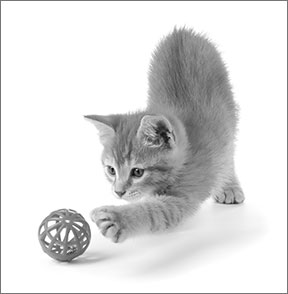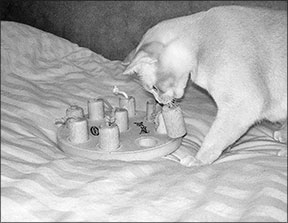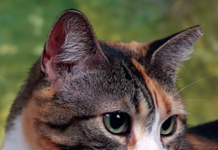Does your cat lie around and sleep all day? It’s true that cats sleep up to 18 hours a day, but it’s not natural or normal for them to be completely inactive. Cats are hunters at heart. To be at their best, they need opportunities to stalk, spy, chase, climb and pounce.

“Lack of stimulation can lead to apathy, obesity and, in the worse-case scenario, predatory aggression aimed at the owner,” says animal behaviorist Katherine A. Houpt, VMD, Ph.D., professor emeritus at the Cornell University College of Veterinary Medicine.
In behaviorist terms, cats need environmental enrichment. Because many live indoors with little or no opportunity to roam outside, it’s up to us to fulfill their needs. In one way or another, enrichment feeds all of a cat’s senses: sight, sound, touch, smell and taste. Here are some ways to excite his curiosity and bring zest to his life.
Play Time
“I tell cat owners to set aside a little time in the morning and at night to spend five minutes playing with the cat,” Dr. Houpt says. The cat will let you know what times he likes to play. All you have to do is be there. His toys don’t have to be expensive. A favorite toy is hair scrunchies that someone has worn, Dr. Houpt says. A few cats, mostly Siamese, will ingest fabric so be sure to check that the scrunchie is still intact after a play session.
Of course, plenty of other types of toys for feline entertainment are available: electronic mice to chase, catnip toys and a circular device with a ball inside that the cat can bat with his paw. “Cats usually aren’t interested in that too long, but you can put their food in there so they have to scoop it out, and that, I think, is enriching,” Dr. Houpt says. If you feed dry food, you can put the cat’s meals inside a puzzle toy so he has to push it around to get fed.
Cats mostly enjoy interactive and predatory play. Dangle a fishing-pole toy with a feather or other object on the end for the cat to bat at or pull it for him to chase. Many cats enjoy chasing and retrieving small balls. For a simple homemade toy, crumple a piece of paper.
I Spy
You may have seen your cat sitting in front of a window, chattering excitedly at the birds or squirrels outdoors. Cats are highly visual, more so than dogs, Dr. Houpt says. Videos and window perches are great ways to stimulate them visually. “They like videos of birds especially or a window where they can watch the real thing,” Dr. Houpt says. “They’ll spend a lot of time watching, even though they must be somewhat frustrated that they can’t get to their prey.”

An aquarium is another good way to provide visual stimulation. Many cats enjoy watching the fish swim back and forth. Just be sure to put a cover on the tank to prevent your cat from going fishing.
Up High
Cats love to survey their kingdom from on high. If you have room and your budget allows, provide a floor-to-ceiling “condo” with platforms and hidey-holes at various levels for perching and hiding. “It is important to give cats things to do and places to hide,” Dr. Houpt says.
Safe Scratching
Scratching is a means of communication for cats as well as a way to groom their claws. Provide your cat with vertical and horizontal scratching surfaces placed in prominent areas, not hidden away in a corner. While most cats scratch standing on their hind legs, some prefer to have three legs on the ground, which is why they scratch your favorite carpet or the needlepoint chair covers. The most popular horizontal scratching aids tend to be made of corrugated cardboard impregnated with catnip.
A kitty condo can double as a vertical scratching post. Look for one wrapped in sisal, a rough, stiff, stringy fiber. Cats seem to prefer its texture to that of the indoor/outdoor carpeting often found on scratching posts.
Touch Me, Feel Me
Most cats love the tactile stimulation provided by petting, massage and grooming. Just be sure you are touching the cat in a way he likes. (See Page 2 for more on petting.) Cats are very particular about where you pet them and the amount of petting they’re willing to tolerate. Favorite areas are between the cheeks, under the chin and at the base of the tail. Be leery of giving belly rubs, even if the cat appears to invite it. Many cats will bite or scratch after just a couple of strokes on the stomach.
The Great Outdoors
It’s dangerous for cats to roam freely outside, but an enclosure in your yard can give them the pleasure of rolling in the grass and doing a little bird-watching. “I’m a great advocate of catios, that is, outdoor enclosures, for cats so that they can be on the ground or at least have another view,” Dr. Houpt says.
If you can’t provide that, consider planting a little indoor garden for your cat with wheat grass, rye or catnip. Even a square of grass from your lawn — herbicide-free, please — will entice him to nibble.
One Caveat
One thing you should not get to enrich your cat’s life is another cat, Dr. Houpt says. “Some cats get along, but many do not. It keeps me employed, but I’d rather there were happy cats instead.” ❖



